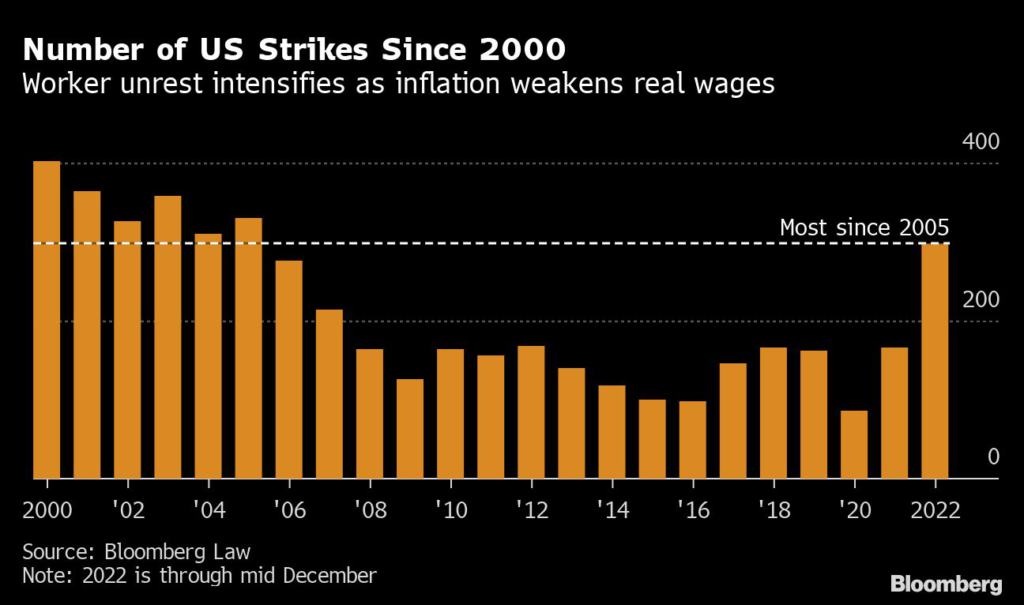(Bloomberg) — Investors positioning for a rally in riskier assets next year may be underestimating the threat from millions of workers around the world protesting for higher wages.
(Bloomberg) — Investors positioning for a rally in riskier assets next year may be underestimating the threat from millions of workers around the world protesting for higher wages.
While signs that inflation has peaked have fueled bets on everything from a weaker dollar to a rebound in global stocks in 2023, there is growing unease among some market strategists that a breakout in labor costs will crimp the flow of money out of havens and into assets that thrive in an economic upswing.
The flipside of this scenario of worker unrest and entrenched high inflation is elevated Treasury yields, a resurgent greenback and demand for physical commodities and value stocks.
Warning signs abound, with labor unrest surging in key economies. UK Border Force workers and railway staff launched fresh strikes Wednesday that Prime Minister Rishi Sunak’s spokesman said were causing “massive disruption.” In one dispute in Germany, some 900,000 workers participated in walkouts before the country’s largest labor union and employers agreed to an 8.5% wage increase. South Korean truck drivers have disrupted the auto, petrochemical and steel industries. And striking Starbucks baristas in Seattle have also grabbed headlines.
Federal Reserve Chair Jerome Powell and his European counterpart Christine Lagarde both underscored the impact of labor costs after hiking interest rates this month.
“This is the definitive battle of 2023 — it’s labor versus the paymasters,” said John Vail, chief global market strategist for Nikko Asset Management in Tokyo. “If wage hikes go through, it’ll be stagflationary and a headwind for markets, both bonds and stocks.”
“Higher rates for longer would potentially mean another leg up in bond yields, which is bad news for investors in government bonds and high-risk corporate debt,” said Shane Oliver, head of investment strategy and economics for AMP Services Ltd. in Sydney.
“It perpetuates the defensive trade and the value trade. It would be a very negative environment for growth stocks,” he said.
Michael Mullaney, head of research for Boston Partners, sees shorter duration, more cyclical stocks doing well if 2023 is a year of persistent high inflation.
“Stocks with long, long tails of earnings distribution will continue to suffer in the higher-for-longer interest rate scenario,” said Mullaney. “Value stocks do well and commodity plays, whether materials or industrials.”
1970s redux
Cash would also find fresh appeal, according to Nikko’s Vail, mirroring a winning trade when the mix of inflation and low growth sapped markets nearly half a century ago.
“If you were investing in the late 1970s, the best thing would have been to put your money in a money market fund. Short-term interest rates go up in a stagflationary environment,” said Vail.
The case for putting money into physical commodities is a tougher call, in his view, given that inflation tends to push them up while the weak economy saps demand.
US strikes recorded by Bloomberg Law are running at a 17-year high.
Highlighting what’s at stake, US President Joe Biden turned to a law crafted before the Great Depression to stop rail workers from a strike that would have cost the economy an estimated $2 billion per day. The UK has even turned to the military to reduce disruption caused to airports by strikes.
The median forecast of Fed policymakers is for rates to rise next year and stay elevated before falling in 2024. Yet market pricing for the Fed and ECB rates is for cuts in the middle of the year.
Central banks “view labor as the most difficult part of the inflation equation,” said Kristina Hooper, chief investment strategist for Invesco, who warned that workers hold more sway for wage increases. “There’s a lot more power now and leverage because of tight, tight labor markets.”
Biden’s Labor Cred Risks Cracks Over Pacific Ports Fight
That’s not to rule out the Fed allowing wages to run hot if price increases in other areas like goods and housing begin to abate, she added.
For AMP’s Oliver, a four-decade veteran of financial markets, the wave of worker unrest rekindles images of the picket lines of the 1980s in the US, UK and Australia when workers revolted against economic liberalization.
“We may have come into a world with more worker militancy,” he said. “It’s bad news for investors because it would stretch out the period of high inflation.”
(Updates with UK strike details in fourth paragraph)
More stories like this are available on bloomberg.com
©2022 Bloomberg L.P.










